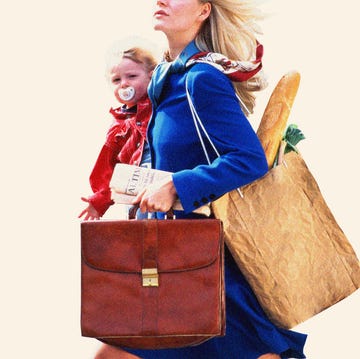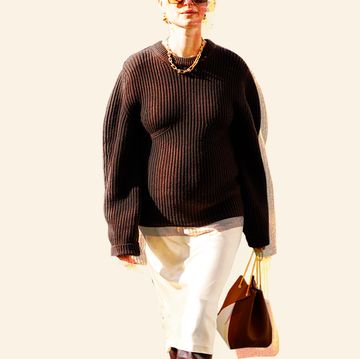This feature is part of ELLE's 'Modern Motherhood Series' - exploring the shifting role of 'mother' in society and the women choosing to do things differently.
If you’ve been on Instagram in the last year – and you follow anything beyond teeth-whitening tricks and dogs on skateboards – then you’ll likely know what a ‘gender reveal party’ is.
For those who’ve miraculously avoided finding out about them, here is your TLDR on the GRP: it’s becoming increasingly trendy to treat an audience of close family and friends, plus whoever follows you on social media, to a suspense-filled ‘reveal’ of your baby’s sex.
Popular gender reveal ideas include popping a giant opaque balloon, which erupts into a sprinkle of pink or blue confetti or slicing a piñata cake to let the blue or pink filling tumble out.
But vying for likes, shares and follows has led to more and more dramatic stunts. Motorcycle exhausts belching out clouds of pink or blue smoke, firework displays in either colour or one parent tattooing the baby’s gender on the other, for example.
A set of expectant parents in Florida even enlisted Hollywood actor Bill Murray for their golf course reveal. Murray’s club connecting with the golf ball produced a puff of blue chalk, the crowd squawks ‘it’s a boy’ and Murray looks characteristically nonplussed about the whole situation. It’s an interesting mood.
As social media stunts go, these all seem on the surface to be fairly innocuous, but considering developing LGBTQ+ visibility and our general reluctance to take a binary view of anything, are gender reveal parties really a bit of harmless fun or are they a step backwards?
I spoke to a range of parents or expectant-parents about their approach to the phenomenon.
In Defense of the Gender Reveal
Quite beyond racking up those Insta-video views, many people think gender reveal parties have their redeeming qualities. For one, they’re mesmerising and for another, to create them is a hell of a lot more productive as a way to pass time than, say, box-set-bingeing over a deep-dish pizza.
‘I think it’s a really great thing,’ says Bushra, 38-years-old and mother to two small boys. ‘There seem to be two types of people, those who are happy to have either gender and those who clearly want one particular gender, so anything that makes the reveal of the gender into a celebration, an exciting and positive moment, is good.’
Amanda, a 36-year-old mother of two, opted for the balloon-popping method at her gender reveal party in London, after being inspired by similar events online: ‘As this was very likely to be our last baby (we already have a three-year-old-girl), we thought it would be nice to share the experience with people closest to us.’
‘We really enjoyed it,’ she continues, ‘and it was good to get everyone together for something special. We would have found out at the scan anyway, so this was a more fun way of discovering the gender even for ourselves.’
‘Look, I know people will be against the social media side of it,’ Bushra chimes in again, ‘maybe some people just want to get likes or demonstrate how crazy or creative they are, but I don’t really care what the motivation is, as long as they have fun with it. If somebody wants to light a heart on fire or pop a balloon to create a memory, that’s nice.’
Finding out The Gender At All
Asking parents about a prospective baby’s sex a decade ago, you’d likely have been met with the response, ‘we don’t care, as long as it’s healthy.’
Which could arguably be a healthier approach to welcoming a new baby. It says ‘we’re just happy to be getting one at all’, rather than, ‘we’re a bit let down that it’s a girl, tbh.’
A piece of 2013 research upended this whole attitude, sending people into on a widespread gender-inquest.
‘Bonding’ has become a parenthood buzzword, with all of us reaching to achieve more of it or show early signs of it and making sure our men are in on it too.
Spurred on by the notion that fathers had often felt shut out of the pregnancy process, Dr Jonathan Ives of Birmingham University set about studying different ways of facilitating the ‘bonding process’ for men, both while the baby is still in-utero and in the immediate aftermath of the birth. He followed a number of fathers and looked at things like the role of health workers in getting men to discuss their feelings, through to the famed delivery room ‘skin-to-skin’ cuddle.
And of everything Dr Ives turned his magnifying glass to, the one that seemed most significant in helping men ‘attach’ – Ives only included men in his study, but the results could just as easily be applied to the non-carrying partner in a same sex relationship, or both intended parents in a surrogacy situation – was finding out the gender.
It seemed to help the non-carrying parent(s) to come to terms with parenthood quicker, by helping them to visualise the baby in the womb as a real person, rather than, presumably, a small, fluid-breathing creature.
'I worried about bonding, as the non-carrying parent,' explains Hannah, who has just welcomed little girl Alex into the world, with her partner Joanna.
'Very much so,' she goes on, 'in fact it caused me anxiety the whole way through the pregnancy, and even a little bit still. We decided that, if possible, Jo was going to breastfeed, so I knew that would be somewhere Jo would bond where I couldn't.'
'I think finding out the gender definitely made it feel more real,' she says, 'and we didn't tell a single other person. I think it made me feel more involved, more of an equal part in everything. It being kept a secret was really difficult for me, but being in our own little club that knew the gender felt so special.'
Hannah goes on to explain, however, that it wasn't finding out the gender which was the defining moment of bonding before birth.
'There was a morning quite late on in the pregnancy,' she says, 'where Jo was sleeping cuddled up, with her tummy right in front of mine, and Alex was doing summersaults up against my tummy. It felt so much more intimate than anything else before it - feeling her move against me. Everyone else had felt her move with their hand, only I got to feel her stick a foot into my ribs.'
Not everyone is comfortable with the mounting pressure on the midway scan gender-reveal as a key part of the bonding process. Journalist Kim Easton-Smith, 32-years-old and currently pregnant with her first child, reckons that we’ve taken Ives’ study far too literally.
‘People are obsessed now,’ she says. ‘I felt that I had let people down by not finding out when I didn’t think it really mattered. And people suggesting my husband and I can’t imagine or bond with our baby on the grounds that I don’t know what sex it is, is ludicrous.’
The emphasis on creating bonding moments for the non-carrying parent is clearly pertinent, but as we've heard, perhaps finding out the gender is not the only effective way of doing it.
Gender Reveal Parties Fuel The Baby Industry
‘I think gender reveal parties are just feeding an expanding culture of ‘baby purchasing’, thinks Federica, 31-years-old and a Public Mental Health and Nutrition researcher at Imperial College.
To Federica’s point, a cursory google of ‘gender reveal party’ throws up a full range of themed paraphernalia, from £30 gender reveal starter packs, through to a £125 Hollywood light-up gender reveal sign. The commercial prospects are fantastically endless for this rapidly expanding market. It’s profiteering at its finest.
‘It’s a bit like the wedding industry,’ she remarks, ‘where savvy manufacturers put a premium on their products if it’s for a wedding, because they know you will pay. The baby industry might be worse, though, because it preys on people’s vulnerabilities at what can be a particularly daunting time.’
‘In reality, a tiny newborn doesn’t need much of anything apart from you, but the baby industry would have you think otherwise. You need a great hospital bag and you need all the stuff in the hospital bag to be the right kind of stuff. You need a Sleepyhead. Oh, no wait, the Sleepyheads are now considered dangerous, so you should probably buy something else. Which cot? Which Moses basket? Which swaddle blanket, buggy, sling carrier, car seat? These things are marketed as necessities. So then, if you add in things like baby showers, birth announcements and gender reveal parties, it’s a huge level of financial pressure on expectant parents,’ continues Federica, who has a one-year-old.
‘If you want to celebrate and you can afford to, then a baby shower probably covers it,’ she finishes. ‘Gender reveal parties are just another way for the outrageously lucrative baby industry to make even more money.’
Why So Binary?
Perhaps more sinister than the independent retailers making a packet on their baby girl-themed confetti cannons is the fact that industry leaders are profiting from what seems to be a pointed return to binary gender classifications.
Below Google’s shopping links, the most highly indexed article is an ‘Ultimate Guide for Planning A Gender Reveal Party,’ on the Pampers.com website.
Clicking through to Pampers you’ll find - below the picture of two cupcakes, one with pastel pink and the other with blue frosting - a list of suggested party themes for your gender reveal event.
These themes include: ‘Bows or bowties’, ‘pirates or mermaids’, ‘quarterback or cheerleader’, ‘touchdowns or tutus’ and if you haven’t spotted the problem yet, let me help you out.
Not only have we put a great deal of work into identifying a number of ‘genders’ beyond ‘boy’ and ‘girl’ in the last few years - hello to all the gender-queer, curious, non-binary and fluid friends in our midst - but we’ve also been working very hard to divorce gender and biological sex, from old fashioned behavioural stereotypes.
For example, we’re finally beginning to dismiss the idea that that boys will wear blue, be macho, sport aggressively, grow up to start fights just as aggressively and have very little to do with the birthing and parenting of their own children.
‘Gender reveal parties encourage gendered parenting,’ says Ronit, a 29-year-old humanist celebrant and mother of one.
‘My son's genitals don't tell you anything about the boy he will be. Gendered parenting sets limits on children, especially girls [who are stuck being the mermaids and cheerleaders]. But patriarchy hurts boys too, and I don't want my son to feel like he has to play football or can't show his feelings,’ she continues.
‘I’m not planning to bring my baby up gender neutral,’ journalist Kim chimes back in, ‘but I think people need to relax about the whole gender thing... babies are just babies.’
If you find yourself turning up to a ‘fireman or housewife’ party in the near future, I suggest you find new friends, but the issue is much bigger than party themes. It’s not just biological sex we seem to be celebrating with gender reveal parties, but also traditional, tired and reductive gender norms.
Kate Parker, author of Strong is The New Pretty, puts it well when she says: ‘You can have both strength and softness. It’s possible to be both – these qualities don’t cancel each other out.’
Out of absolute necessity, for the future of our girls’ education and for the reduction of, dare I say it, 'toxic masculinity' at large, we cannot afford to take, in Parker's words, a ‘simplistic view of what’s expected from [our children].’
Parties are fantastic – honestly, let’s have more of them - and welcoming babies into the world with positivity and surrounded by family is a great approach, but as Ronit and Kim point out, perhaps the process of enveloping them in love also involves warding off the harmful stereotypes that others will try to push on them before they’re even big enough to focus an inch ahead.

Natasha Bird is the Former Executive Editor (Digital) of ELLE.















